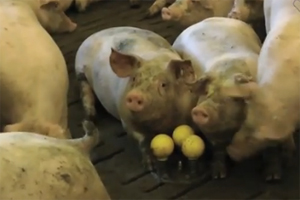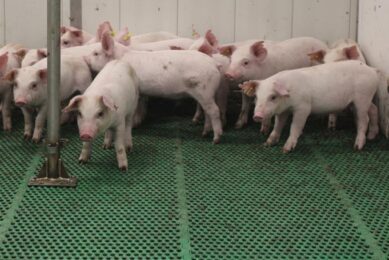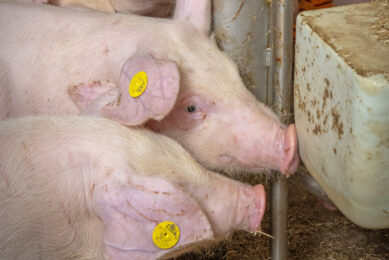Measuring pigs’ enrichment use

If pigs are bored it may lead to undesirable behaviour towards their pen mates such as tail or ear biting and aggression in growing pigs and vulva biting in sows.
Recording pigs’ use of different types of enrichment on a large scale will help to identify which types of object are fulfilling the objective of enriching the pigs’ environment.
Good use of enrichment within a pen of growing pigs has been shown to have a protective effect against abnormal behaviours such as tail and ear biting, and aggression, and in sows against vulva biting, and aggression.
All forms of aggression are costly to the producer in terms of time, medication and performance; and destruction of pen fittings. It is also costly in terms of time spent replacing pen equipment, wasted food and water etc. These costs could be reduced by increasing the use of enrichment.
Providing permanent access for all pigs to objects or substrate for enrichment is a legal requirement; the health, welfare and production benefits of this are only seen if the objects or substrates provided actually keep pigs occupied.
Enrichment scoring provides additional information to assist with advice on the four more direct Real Welfare measures (pigs in need of hospital pen, lame pigs, body marks and tail lesions). For example if a high level of tail biting is observed but the majority of active pigs are manipulating enrichment objects or substrate, then lack of enrichment is unlikely to be a contributory factor and other reasons such as ventilation, health or access to resources should be considered.
Behaviour can be used in the evaluation of a wide range of both health and welfare issues and can be considered a reliable non-invasive indicator of an animal’s ability to cope with its environment. The science of animal behaviour employs a wide range of techniques which can be used to compare animal welfare in a range of different situations e.g. effects of different housing conditions, stocking densities, temperatures, gas concentrations, light levels etc. by measuring activity patterns, often in terms of frequency, duration, and prevalence, with different methods applicable in different situations.
The development of the Real Welfare enrichment use measure since 2004 has focused on one key indicator measure – pigs’ use of enrichment. The score is collected as a count of active pigs using enrichment and a count of active pigs rooting or chewing on other pigs, pen fittings, or bare floor. The number of additional sitting or standing pigs is also recorded as a guide to the level of activity in the pen.
While this may appear to be a rudimentary method of recording behaviour, it focuses on one practical question, rather than trying to examine all possible activities of pigs in the pen. This “shorthand” method (one scan of all active pigs in the pen) showed significant correlation with a more complex method identifying 13 separate behaviours, alongside frequency and duration estimates, which could take over 10 minutes to assess larger pen sizes (as opposed to one long scan of behaviours).
Importantly, both methods gave scores which were significantly associated with the presence of tail biting in the pen – more enrichment focused pens showed less tail biting and other skin or ear damage.
The score is robust and gives comparable results, however many pigs are active in the pen. This measure can be recorded at any point during the assessment (from a viewpoint outside the pen); if vets choose to score the pigs before entering the pen to take other measures fewer pigs will be active, but this will give an equally valid score for the pen.
The advantage of enrichment use as a measure is that in most pens some animals will be using enrichment and some will be rooting or chewing on other objects or pigs in the pen – this gives a range of “prevalences” that be compared. Other key behaviours such as play or mounting are rarer, and the behaviours are generally of shorter duration, making them harder to record and compare accurately. Some authors consider that manipulation of non-food objects can be classed as play.
The enrichment use measure concentrates on standing and sitting pigs in the pen – not only are these easier to observe because snouts and mouths are not hidden amongst other pigs, but these are the ones showing a deliberate choice in behaviour. Contentedness and welfare of pigs can be measured in resting animals, but requires observation of more subtle cues over a longer period of time.
Play behaviour is understood to be an indicator of positive effect and optimal environment – however its occurrence in finisher pigs (and sows) is considerably lower than in weaners and growers (in most animals play behaviour reduces with maturity, and also differs between males and females). During development of the protocols, locomotor and social play were also considered, but their occurrence during observations was rare. Presence of play behaviour during finisher observations can be considered a “positive” indicator, but its absence is not necessarily negative. Play is more likely in some situations (e.g. novel enrichment provision, and space for locomotion) than others. Even among published papers, it is recognised that the distinction between play-fighting (a form of social play) and fighting is difficult to define – bouts that start as play fighting may become true fighting.
Mounting is a behaviour with strong welfare implications both for the recipients and perpetrators –Real Welfare protocols record it indirectly by effects on the recipients (rather than observing the behaviour at the time) and its occurrence at problem levels can contribute to the discussion of measures required. Mounting behaviour can be a contributory factor in Real Welfare measures of body lesions, lameness and pigs in need of hospitalisation. The outcome measure of mounting is observed as patterns of parallel scrapes around the shoulder areas of the recipient (i.e. trotter scrapes), which can be classed as severe if the mounting behaviour is prolonged on the same recipient e.g. as large areas of reddened, scraped skin, and can potentially lead to lameness, and/or classification of recipients as in need of hospital pen e.g. due to lameness, exhaustion or crushing.
In summary – the scoring protocols have been developed as a robust way of assessing enrichment use by pigs which complements the more direct measures and assist in addressing underlying causes. Enrichment is likely to be in use by a proportion of pigs in most pens, giving a score that can be compared between units, rather than other behaviours which can be more hit and miss. The protocols have been focused to give a “shorthand” scoring system to look at the usefulness to the pigs of the objects or substrate provided as enrichment, rather than more time consuming conventional methods. The methodology takes into account the activity levels of the pigs and can be done at any point during the assessment protocols without invalidating the results. Recording the types of enrichment present and in use will help to improve our understanding of relevant enrichment objects and substrates to provide.











